Fountain pens are a regular topic of discussion here at the Gentleman’s Gazette, but a true gentleman knows that not even an expensive pen can compensate for poor handwriting. While the art of penmanship seems to be on the wane, we believe this gentlemanly pursuit still has a place today, and that handwriting should be as clear and beautiful as the ideas being put on the page.
For centuries, from the Middle Ages’ illuminated manuscripts to the florid, personal correspondence of the 18th and 19th centuries, the ability to produce writing that was not only legible but also beautiful was a sought after and highly vaunted skill.
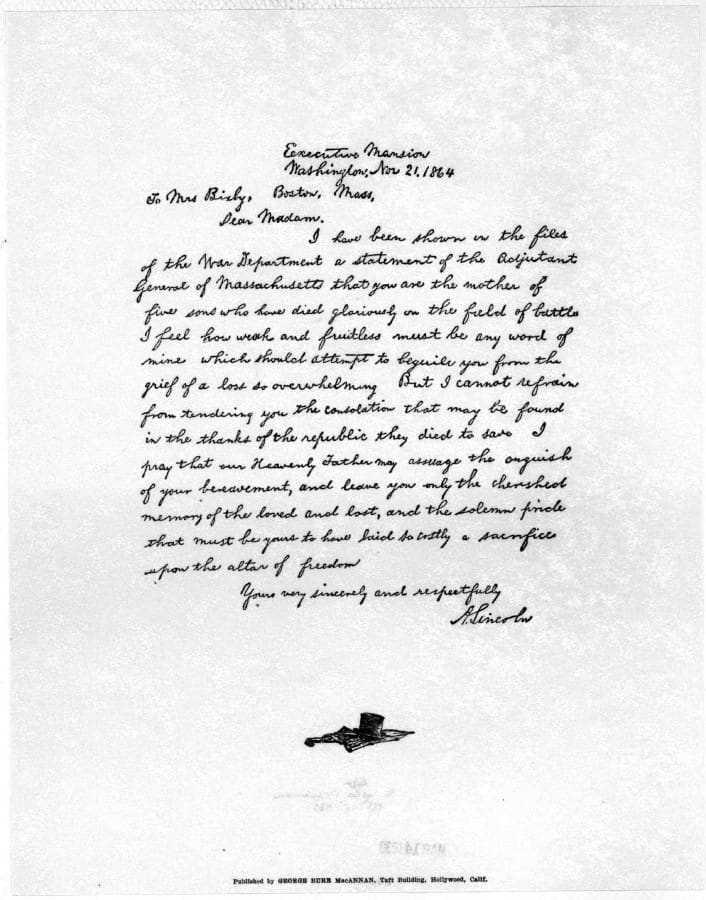
Over the 20th and into the 21st centuries, however, cultural and technological changes have many people convinced that handwritten correspondence is a thing of the past. As such, an emphasis on good handwriting has also declined precipitously in recent decades. The printed script is used only when filling out forms or scribbling notes, and, for many, cursive has become consigned exclusively to signatures.
The Modern History of Penmanship
So, to find out how this all occurred, we’re going to investigate the recent history of penmanship with a special emphasis on the fountain pen and try to uncover the various factors that led to its decline. And, for the sake of brevity, we will be focusing on penmanship from a largely Anglophonic perspective and looking only at fairly recent history.
The modern history of penmanship began in the middle of the 18th century when a culture of written correspondence through letters proliferated in Europe and North America.
It was considered a mark of intelligence and good social standing for one to write beautifully and legibly, so handwriting was taught in both public and private institutions. In fact, some special schools arose that catered exclusively to teaching penmanship. Guide books were also offered, and the first North American volume entitled “The American Instructor” was published in 1748.

While there came to be many methodologies for proper handwriting and penmanship, one of the most influential arose in 1809 from Joseph Carstairs, a British educator. He believed that writing ought to be formed smoothly and made up of one continuous stroke rather than having letters formed from multiple individual strokes as had been done previously.
The result was a broad and fluid script that could be written quickly and efficiently, utilizing the entire arm’s movement to maintain speed and control without cramping in the wrist or the fingers. This fluid style was particularly useful when writing in cursive.
Fountain Pens – Favored For Cursive Writing
Penmanship courses during this period covered both cursive and printed script, but because cursive allowed one to write quickly as the pen didn’t need to be removed from the pages often, it was favored for most handwritten documents. As cursive was the favored script beginning around the middle of the 19th century, the fountain pen became the favored writing instrument.
We won’t delve fully into the fountain pen and all of its intricacies today. But, for an extensive analysis, including how it works and its history, our Fountain Pen Guide has you covered.
For now, suffice it to say that by the end of the 19th century, the fountain pen had become the almost universal instrument for written correspondence and for good reason; the fountain pen’s nib allowed for a multitude of fine detailing and precise strokes, as well as for the even distribution of good quality ink that easily maintained a consistent flow, and, in particular, the internal ink reservoir of most fountain pens eliminated the need to return to an inkwell or inkpot to refill the pen as one had to do when using a dip pen or its antecedent, the quill pen.
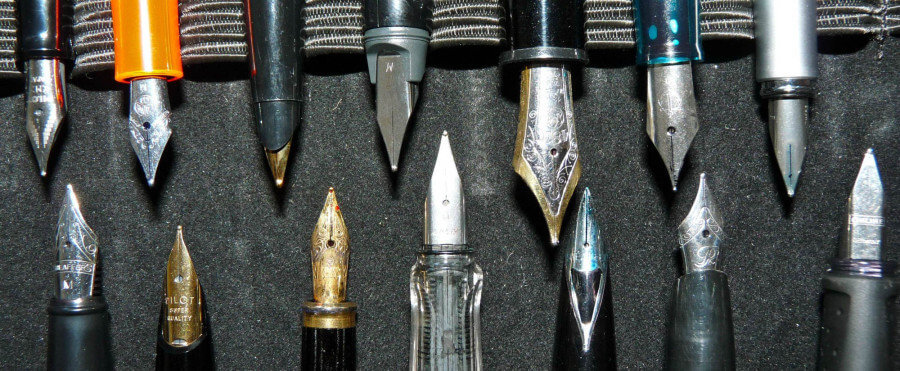
As the 20th century began, penmanship was considered fundamental to elementary education, and the fountain pen reigned supreme among writing instruments. Armed during grammar school with sharpened pencils, students of good handwriting in the 19th and 20th centuries would dutifully copy out individual letters and later phrases, sometimes filling up entire copy books as they practiced.
While dozens of different writing manuals were employed in North America, the most popular of which were the Palmer and Zaner-Bloser methods, nearly all of them assumed that students were preparing to write with fountain pens. Even later, writing systems like the D’Nealian method developed in 1978 maintained norms established by the Palmer method, such as the suggested writing grip, which were more suitable to fountain pens than ballpoint pens.
As students in the mid to late-20th century rose through the schooling ranks and entered the working world, however, many of them began to write with ballpoint pens, again, for their low cost and perceived convenience. Indeed, ballpoint pens also came to be distributed in schools for this same reason. And, as you might expect, because there was a discord between the tools used and the methods taught, penmanship in schools did decline somewhat.
Despite these impediments, cursive handwriting continued to be taught in American schools well into the 1990s, though it was increasingly seen as archaic. Also, to the many drawbacks we already mentioned, many teachers thought that the method of teaching cursive handwriting, which relied on rote skills and repetitive practices, amounted to simple drudgery. Other schools de-emphasized cursive handwriting or removed the course entirely, perhaps to focus on increasing amounts of standardized testing coming into vogue around that time.
Today, most American schools do provide rudimentary instruction in basic penmanship, but cursive is exceedingly rarely taught. In Europe, meanwhile, courses on cursive and penmanship are still somewhat more widely taught, and some students are even instructed on how to use a fountain pen. But, all of this instruction is somewhat in decline in Europe as well.
Preston’s Personal Experience in Penmanship Training
Speaking personally, I was taught the D’Nealian method for printing in elementary school and was also instructed in cursive as a third-grader in 2003. Cursive wouldn’t be emphasized in further years of my schooling, however.
I did stick with it, although I’m sure that some of my letterforms have taken on unique shapes over the years. I did notice, though, that I was one of a small handful of students out of my larger class of 200 or so who did keep up with writing in cursive.
Penmanship: A Dying Art?
One of the first causes for the decline in penmanship came from the invention of new pen technologies. For all of its many benefits, the fountain pen wasn’t without drawbacks. In particular, the refilling process could be time-consuming and indelicate handling could lead to ink stains and spills. Also, fountain pen nibs were very delicate and could be easily damaged, especially on rough surfaces.
Massachusetts inventor John J. Loud attempted to fix the delicate nib issue by creating, in 1888, a pen that dispensed ink via a tiny ball at its point. That is to say, a “ballpoint pen.” Loud’s pen, though, had difficulty maintaining ink flow, and its practical utility was severely limited. He himself had only intended for it to be used to write on industrial materials like the rough leather used by tanners in the late 1930s.
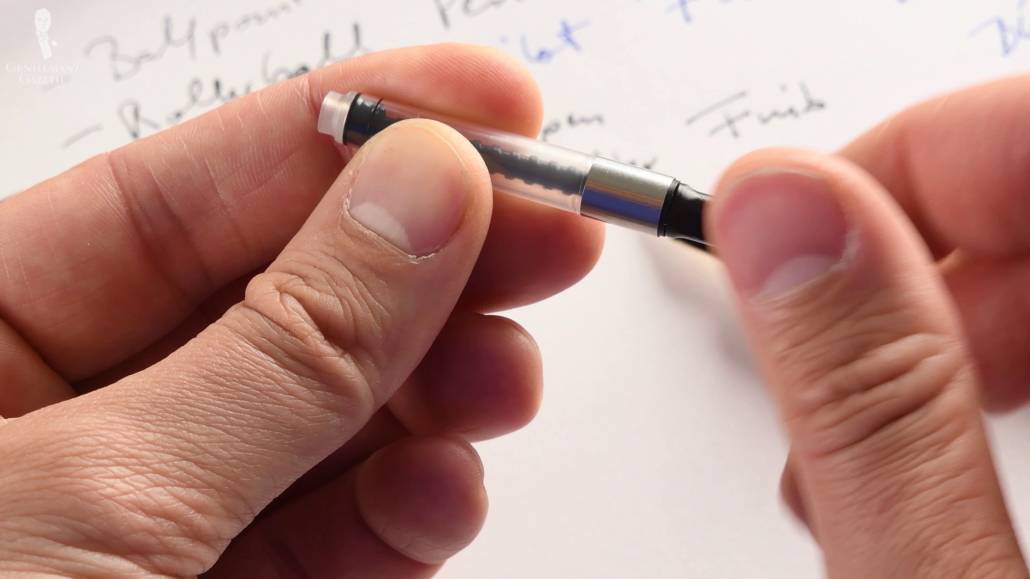
László Bíró, a Hungarian journalist, improved on Loud’s design by introducing a new, more viscous ink developed by his chemist brother György. This new, more paste-like ink could still be delivered through the ball at the pen’s point, but with a more consistent rate of flow that led to more legible writing.
Bíró’s pen design grew in popularity and, shortly after the conclusion of World War II, the design was sold to Marcel Bich, the co-founder of the now-famous Bic pen company. By the 1970s, a variation on the ballpoint pen with a more smoothly flowing ink was introduced. This became known as “the rollerball” or “gel rollerball pen.”
So, how did these newer pen designs precipitate the decline of penmanship? Well, remember first that the ballpoint pen wasn’t originally designed for fine writing. Loud wanted a way to write on rough surfaces like leather, and Bíró needed a pen that wouldn’t need to be refilled often and would be good for scribbling out notes or editing newspaper stories. So, the ballpoint is fundamentally a utilitarian pen. It’s good for writing things out in simple script, but it doesn’t lend itself well to the more beautiful art of traditional handwriting.
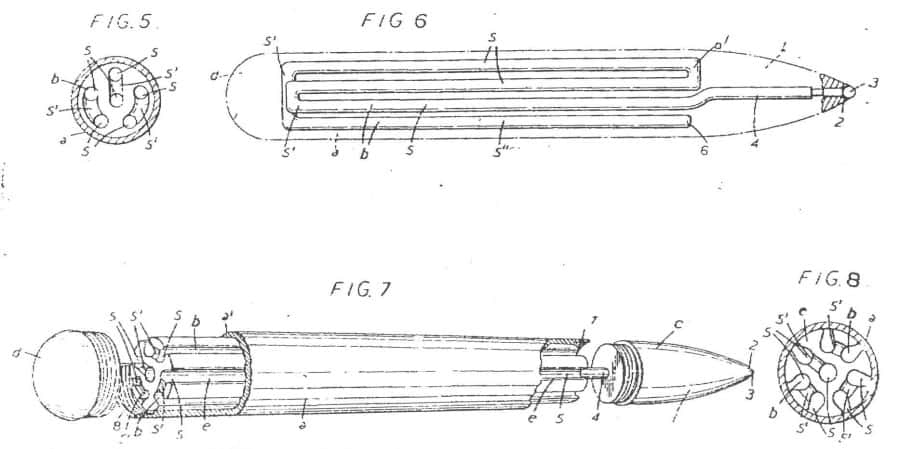
The round tip, unlike a fountain pen’s nib, can’t be used to create lines of varying thickness and can’t be finely controlled. And dispensing the paste ink requires firm and consistent pressure that can lead to a more uncomfortable experience and, indeed, cramping of the hand and doesn’t allow for the whole arm. This will affect not only comfort but also speed and will make it difficult to continue writing for long periods of time.
While gel rollerballs have much-improved ink flow and address many of these concerns, they also can’t produce lines of varying thickness, and, like ballpoints, gel rollerballs also tend to be more poorly balanced compared to fountain pens. One can certainly achieve fine handwriting with a ballpoint pen or gel rollerball, of course, but their designs aren’t conducive to fine penmanship. Ultimately, they’re more of a convenient option.
Fountain Pens: Now Relics of An Earlier Time?
So, how did the new pen styles manage to supplant the superior fountain pen so quickly? One of the major reasons, as you might expect, is cost.
When the modern ballpoint pen was first introduced in 1945, it sold for $10, which, when adjusted for inflation, would be about $120 today. This was only slightly less expensive than fountain pens of the time. To better compete with fountain pens, ballpoint pen manufacturers found a way to reduce costs by utilizing cheap labor, materials, and manufacturing.
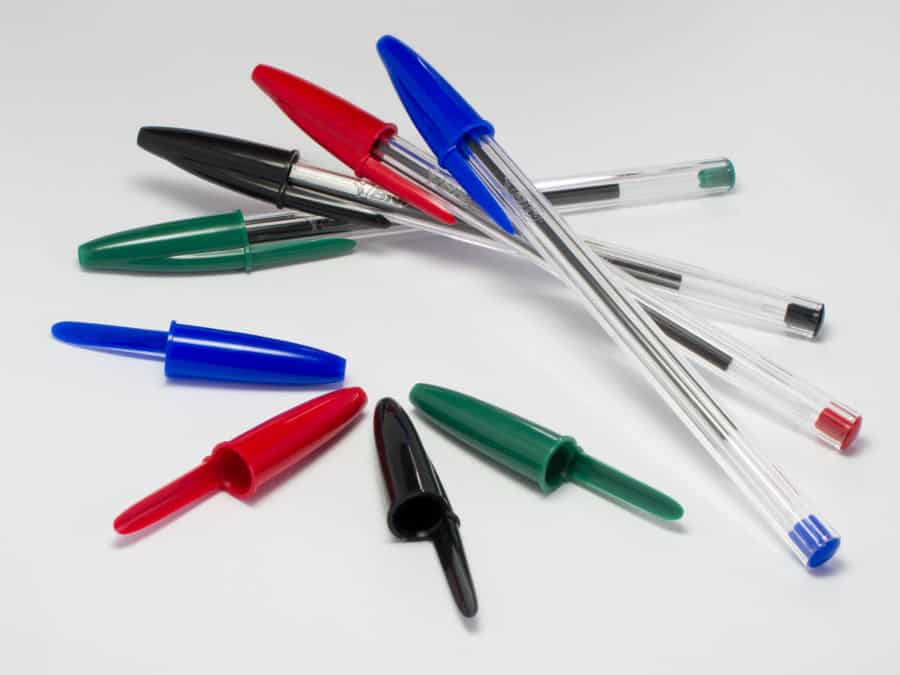
In 1959, Bic debuted its Cristal ballpoint pen, which retailed for just 19 cents or about $1.70 in today’s money. And today, of course, you can get a multi-pack of Bic Cristals for less than 5 cents per pen.
In the mid to late-20th century, consumers flocked to what was cheap, convenient, and disposable, so the ballpoint pen became ubiquitous. But, as standards in both workmanship and ink declined, the problems inherent to ballpoint pens only became further exacerbated.
Quality Penmanship Required Quality Pen
The pursuit of ever-lower prices advanced a pen that was poorly suited to the art of fine writing and, thus, negatively impacted the art of penmanship overall. Ultimately then, quality penmanship best requires a quality pen. And, as you might expect, quality has a cost to it. However, this doesn’t necessarily have to be a high cost.
There are excellent fountain pens available today that cost nothing more than what you would see from a quality ballpoint pen. For example, the Pilot Metropolitan, which retails for around $15, is one of our picks in our roundup of inexpensive fountain pens.
But, if you’re continuing on your fountain pen journey and looking for a step up from the base level models, you may find our guide to intermediately priced fountain pens helpful and our assessment of the hefty-priced Montblanc Meisterstück might be something you’ll enjoy.
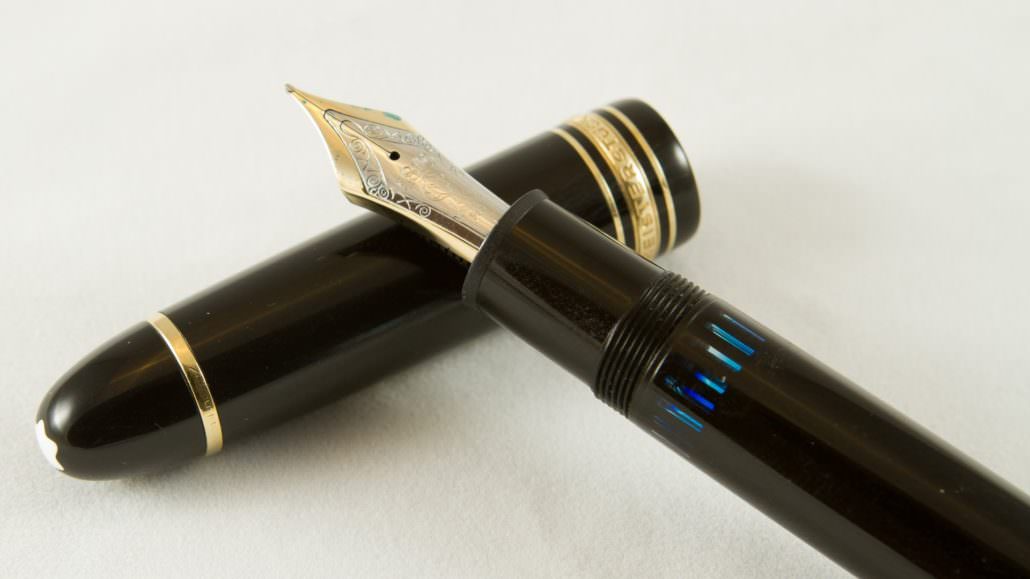
A perfectly honed instrument like a fountain pen is fundamentally an investment, then. And you should expect to invest not only money but also time and practice. Indeed, no matter the pen you choose to use, good penmanship requires time and dedication to master.
So, while it is true that mastering the art of fine penmanship does require a considerable amount of work, one will typically find that putting in the investment will give exceptional dividends and, indeed, a good deal of the strife and frustration that some associate with practicing penmanship can be alleviated simply by practicing with a fountain pen instead of a ballpoint or rollerball.
On that note, our guide on How To Write With A Fountain Pen will teach a beginner everything they need to know about using a fountain pen, and also have another guide on mistakes you can avoid when doing so!
The Art Of Penmanship Requires Time & Dedication
Fortunately, learning to write with a fountain pen is a skill that a gentleman can easily master in the comfort of his own home. All he needs to do is find a set of letterforms that he likes, copy the upper and lower case letters, and then get to work practicing them. Then, once he’s mastered the letterforms, he can start trying sentences.
Pangrams like “the quick brown fox jumps over the lazy dog” will ensure that he gets to practice with every letter and multiple loop and ligature arrangements.
The Decline In Penmanship & The Rise Of Technology
But, to return to the central question of today’s post, improper pen usage, lower quality writing instruments, and a decreased focus on teaching penmanship in schools led, somewhat, to the decline of penmanship. However, this wasn’t the only factor and certainly not what delivered the death blow.
While the widening distribution of typewriters in the 1930s and ’40s caused some to prophesize that this would lead to the death of handwriting, these predictions were largely ill-founded. Other than business and legal correspondence and other professional applications, the typewriter was too expensive and too impractical in most circumstances for everyday activities like taking notes or writing letters. So, penmanship persisted.
However, all this changed at the close of the 20th century when access to cheap word processors and desktop computers made it easy for anyone to type almost anything. Schools that had previously taught penmanship began to teach typing and keyboarding instead. Home printers made it more convenient to print out rather than write out school or work assignments and even personal correspondence.
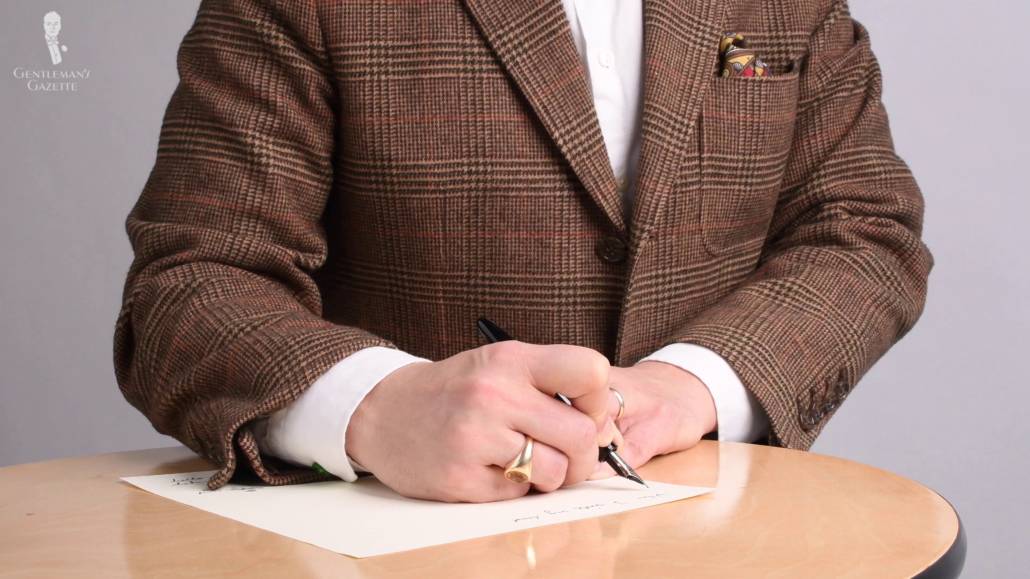
Furthermore, with the rise of email and online chatting, handwritten letters were dismissed as snail-mail, and digital communication was the preferred way to keep in touch for a generation fixated on lightning-fast speed, minimal effort, and the latest technological trends.
Finally, mobile phones and, especially, smartphones provided a convenient, adaptable, and omnipresent way to almost eliminate even quotidian forms of writing like shopping lists, schedules, and short personal notes through specialized apps. Today, some schools have even organized all digital curricula, outfitting their students with individual laptops or tablets.
Will Handwritten Communication Soon Reach Its End?
The changes and innovation we see in handwriting may imply that we’ve finally reached the last days of penmanship and that soon, all communication will be digital? However, we don’t believe this will come to pass.
Commentators have been predicting the death of handwriting for decades now. While new technologies have definitely supplanted handwriting in some areas and are easier and more convenient, there are certain things that digital communication can’t do as well as handwriting.
It should be no surprise that here at the Gentleman’s Gazette, we often prefer to do things the classic or old-fashioned way. There’s nothing more classic (not to mention warm and personal) than a handwritten thank you card to a great client, a personal letter to a friend, or even a humble postcard to one’s parents.
It should also be reinforced that penmanship is a valuable art in and of itself as it will allow you to create something unique and beautiful. And for some, copying out letters while practicing your penmanship or falling into the trance of writing a long letter can have a relaxing and almost meditative quality.
Moreover, when you consider that studies have shown writing things out by hand improves memory retention and speeds mastery of new information, we think that there’s definitely still a place for focusing on penmanship today. And after all, if there weren’t a place for focusing on penmanship, what good would all these fountain pens we have be?
Conclusion
So, if we’ve made one thing clear today, we hope it’s that penmanship and the particular charm of a handwritten letter are not bygone relics. But instead, personal and beautiful mementos of a more elegant age. We hope you’ll consider taking up a fountain pen, practicing your penmanship, and writing out more letters and thank you cards soon.
Outfit Rundown
I’m wearing a more casual outfit, good for sitting around the house and writing out some handwritten correspondence.
It consists of a heavily-textured brown cardigan sweater worn over an off-white shirt and navy blue trousers with a subtle bird’s eye pattern to their weave. While the shirt is French cuffed, I’ve just got simple black links in the cuffs today, and they’re configured in a barrel style to fit more easily under the sleeves of the sweater.
My shoes are dark chocolate brown, suede penny loafers to harmonize somewhat with the sweater and my remaining accessories are from Fort Belvedere. These include my pale yellow knit tie in silk and my socks, which are two-toned shadow striped models in navy blue and yellow to harmonize with both the trousers and the tie. You can find the tie and socks that I’m wearing, as well as a wide array of other menswear accessories in the Fort Belvedere shop.
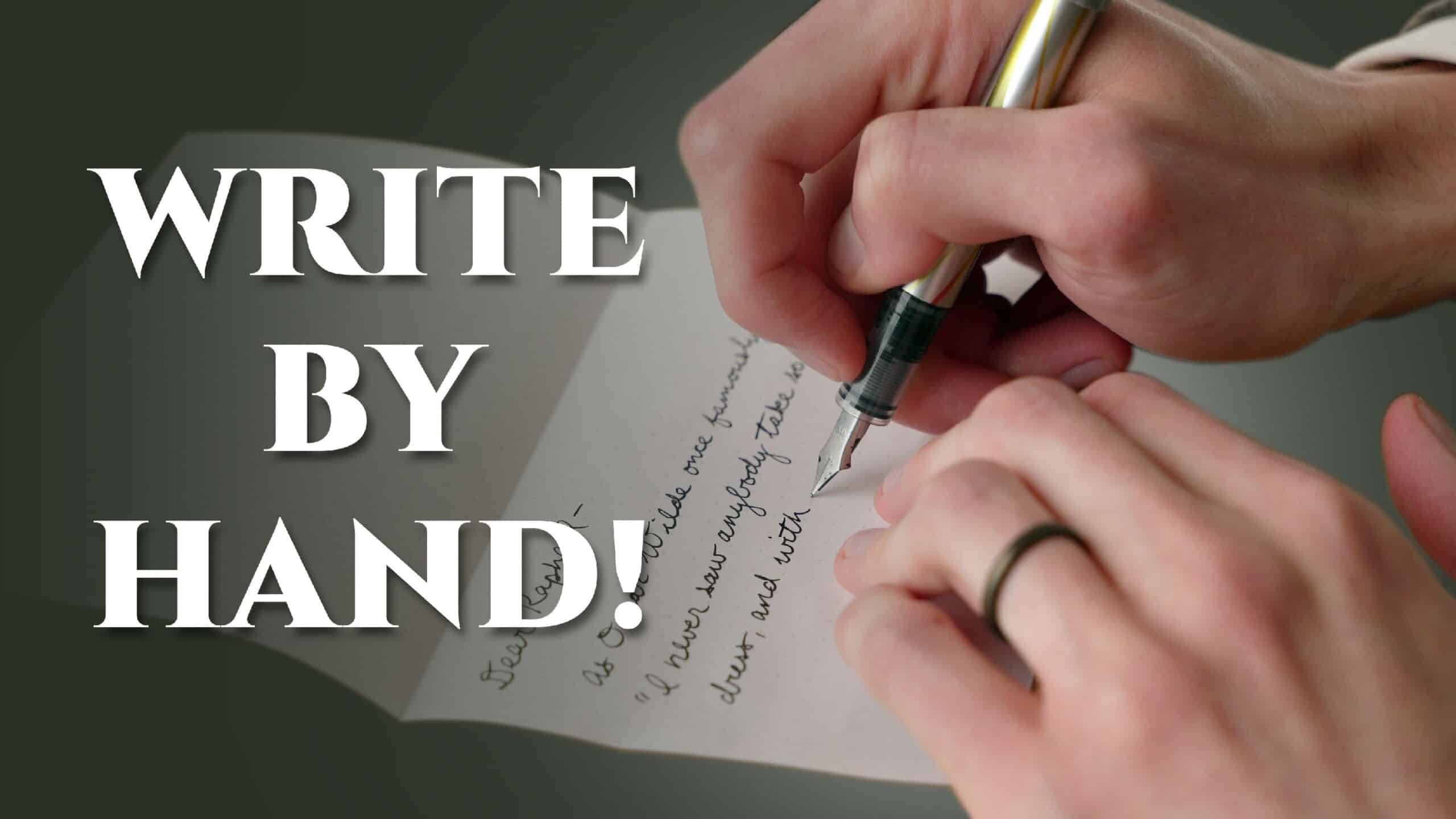



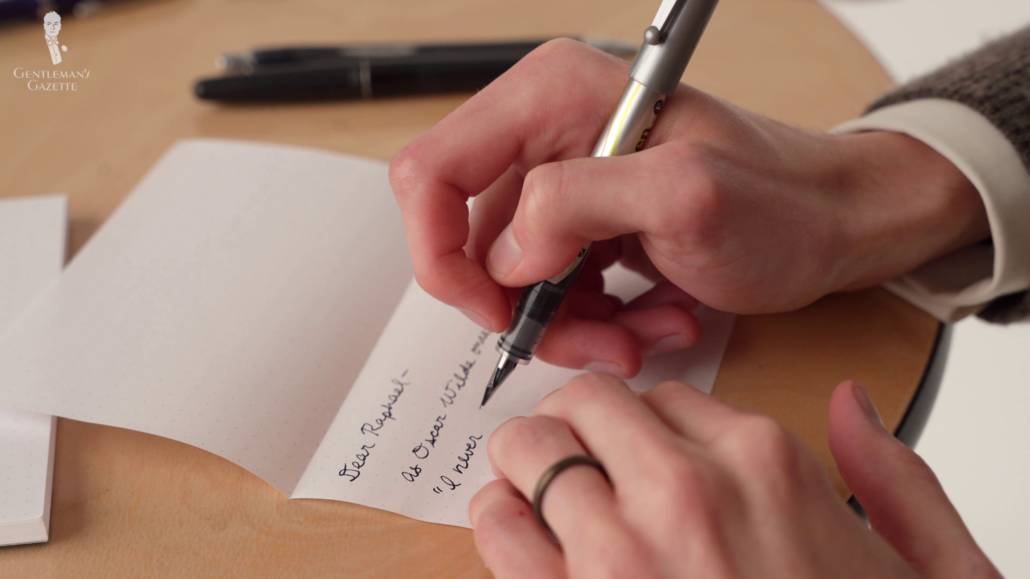
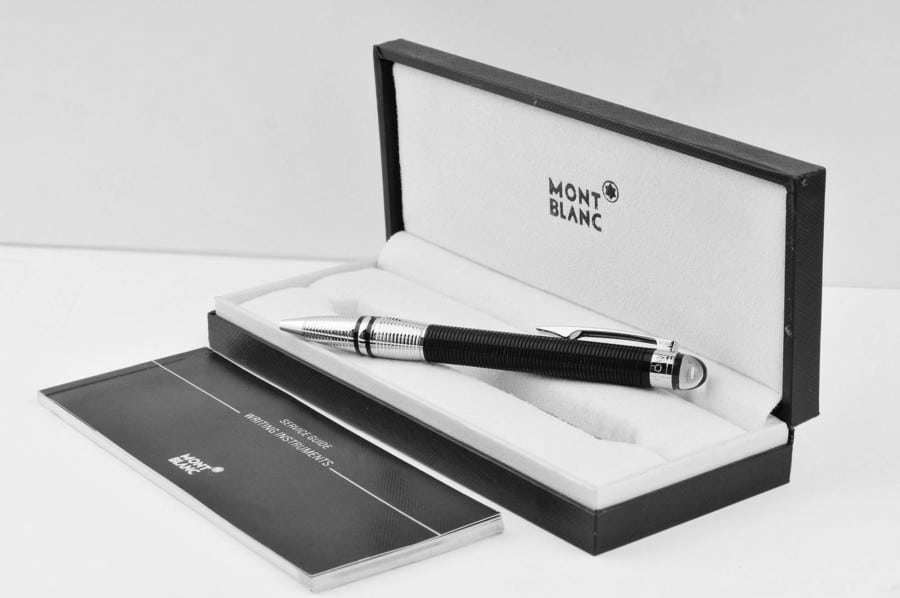



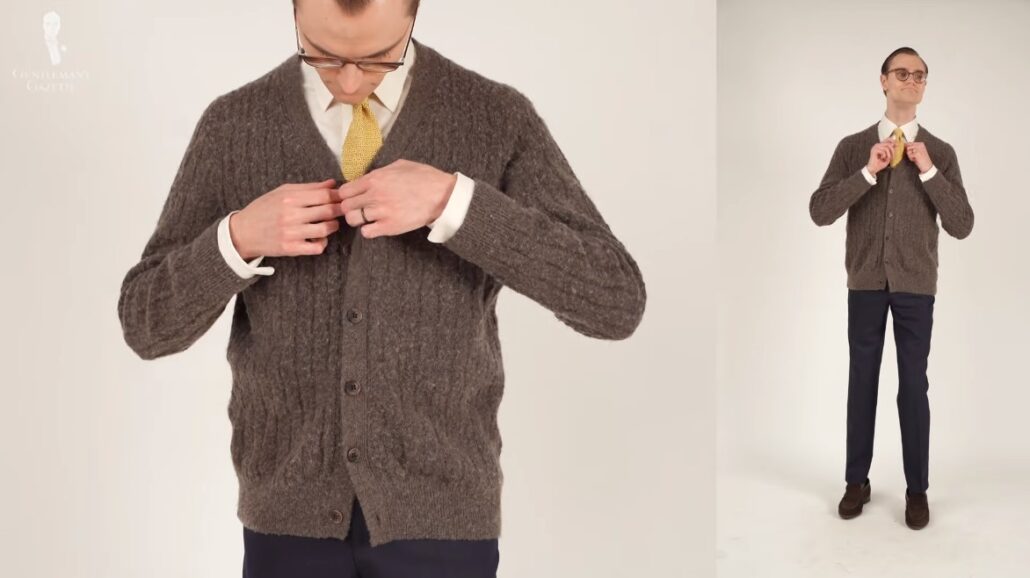
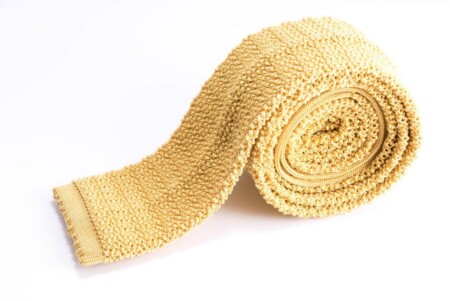
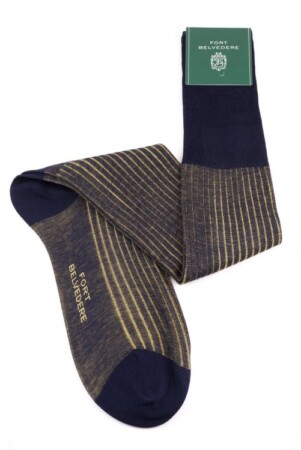
The quality of writing paper is a factor in good handwriting too.
Good point! :)
When I attended school at U.C. Berkeley I found that taking notes in class with a ball-point pen was too slow, so I tried a Pelikan 120 fountain pen to see if it would help. It did, and the ability to switch ink colors helped me organize my notes. Soon I started coveting a Montblanc 149 in a local stationery store (for the outrageous price of $75!) and at that point I became hooked on fountain pens. I gritted my teeth, bought it, and beat the hell out of it with hard use. After I graduated I sent my beloved 149 in to be repaired and got it back good as new except for a few negligible signs of my abuse. Now my collection has grown to 14 pens, but my penmanship is still quirky and not at all in the cursive style.
I bought a fountain pen for myself as a christmas gift. As well as some quality paper to write upon.
My biggest surprise was the flowing of the pen over the paper. As you point out, writing with ballpoint tires the hand/wrist, so I expected the fountain pen to do the same.
It was a very pleasant surprise.
My handwriting used to be positively miserable and I got tired of all the, “You should have been a doctor” jokes. I learned how to write in Italic (a European form of handwriting) in about two weeks using the Barchowsky Fluent Hand “Fix it Write” booklet, and now I’m complimented all the time about how beautiful my handwriting is. I like this much more!
I use fountain pens primarily, but not just for their aesthetics. When writing with ballpoint pens, I used to press so hard, it would hurt my hand and wrist after a short period of writing. You can’t write with high pressure using a fountain pen without breaking it, so it forced me to change. So, fountain pens: good for beautiful writing, good for non-cramped hands.
I still hand write all my thank you notes, and occasionally get feedback both on my thoughtfulness and my penmanship, (eight years in grammar school, with both the Palmer and Rhinehart methods).
Nice “write up”. Don’t forget DuPont pens. Ive had some for 40 years. Big Crystals still work!! Funny my original Apple Newton couldn’t pick up my handwriting but what an invention. Thanks for good articles you have been producing. I wear custom made Wildsmith shoes from London that i think are 50 years old. Quality wears well!!
I love handwriting, and I still use the old Parker fountain pen my grandfather carried when he returned to Majorca after forty years of living and working in America. It’s my favourite pen among another twenty ones, and I use every day. I think it is a chain trough the years with a man who worked all his life trying to get his family the best.
Greetings,
In addition to writing notes and letters by hand, I also make a point to further personalize the missive by having a variety of postage stamps available.
I try to reflect the recipient’s personality or sensibilities with the subject or theme of the stamp.
Recently, U.S. stamps have featured Elvis Presley, Ingrid Bergman, John F. Kennedy, George H.W. Bush, Gwen Ifill, Repeal of the Stamp Act, The Battle of New Orleans, and Bugs Bunny.
That is a fairly representative collection.
Best regards,
Andrew Gregg,
Palm Springs, California.
I would love to be able to write notes in cursive, but owing to my being left-handed I need to have lines to follow unless I want my notes to wander the un-lined page. Using a fountain pen resulted in notes looking like Charlie Brown wrote them. He wasn’t the only one to have smearing problems. Now I only write my name. When I bought my first house, I had to sign my name 51 times on the triplicate purchase offer forms. I’d say there were about 40 different signatures on those pages; none of them worthy of bragging about.
Typically I write in a hybrid of the Palmer Method and Zaner-Bloser Methods of Penmanship. I’m not incredibly fond of D’Nealian. I’ll also write in a Spencerian hand from time to time.
As for writing instruments, it depends on what I am writing. For English or History notes, I’m more likely to use a fountain pen, but for something like Chemistry, I tend to favor a ballpoint pen because I can exert greater control over it when writing out formulas and I don’t really need to worry about my ink bleeding through the paper.
For fountain pens, I switch between a Parker IM and a Cross Bailey, or a Scriveiner fountain pen. For ballpoints, I stick with a simple BIC Cristal though I do use a Parker Jotter at times (and when my fingers can handle it. It’s so thin!). Sometimes I’ll use a Pilot G2 in 0.5 or 0.7 as well.
Great piece Preston. Enjoyable and informative. BTW, a tip of the vocabulary hat; “quotidian”.
I was schooled in the D’Nealian method of writing in 3rd grade(1953) and the ease of muscle memory compels it’s continued use. Having recently retired from 22 years on the adjunct faculty of a local branch of our state’s university system I can attest to the pronounced decline in penmanship. By the end of my tenure, all student hand writing was printed. Once in a while I would encounter a student that had escaped the clutches of the public education system and was still using cursive. I found that sloppy printing was no more legible than sloppy cursive. There’s just no substitute for good penmanship.
I was introduced to fountain pens in 6th grade(1956) with the purchase of a very affordable Sheaffer clear plastic fountain pen with drop-in ink cartridge. I used that pen for years and may still have it somewhere about the house. Of late I had fallen to using roller ball pens. But you have rekindled my interest. So, I’ll dust off my Rot Ring Core and put it back into service. Thanks.
I regularly use a fountain pen. The Rhondda Tunnel Society have recovered hardwood keys from the currently closed tunnel and turned into pens to raise funds; I have had the fountain pen version. As it is not a cartridge type I have bought my first bottle of Parker’s ‘Quink’ for 45-years.
I have stopped by 5 or more stores specializing in the sale of high quality pens and writing materials and none of them sell books on handwriting. This include a store at the Mall of America in Minneapolis. It seems like a lost opportunity to me. Even Amazon.com doesn’t have much in the way of books to help you improve penmanship.
Allan, check out the Barchowdsky Fluent Hand booklet “Fix it write”. It did the trick for me. I recommend it all the time.
Thank you David. Really appreciate the great suggestion.
I am of the age that the ballpoint was a novelty of my youth; however, I discovered that Law school was imminently more tolerable taking notes with a fountain pen. I am now a bit of a collector and I carry one with me at all times.
You are so right on so many levels. My few pens are amongst my most treasured possessions. Each is an individual instrument which brings its own characteristics to my writing. One of the small joys of life is an old and well-loved pen in this all-too-utilitarian, throw away world.
I have a wide range of roller ball pens and a few fine fountains as well. I think taking the time to write longhand helps to remember things as well, in ways that simply typing cannot. I am never without a notebook and pen of some kind along, although for traveling I do remain dedicated to ballpoint resulting from one unfortunate incident in which a notebook became wet and the fountain ink bled, ruining my travel journal. But for office use, I always maintain good quality pens, inks, and notebooks. It is a gentlemanly tradition I will never surrender.
Thank you everyone for sharing! Reading your comments gives us joy knowing that we all share the passion for handwriting and of course, collecting fountain pens! ;)